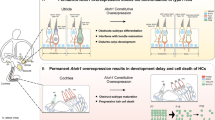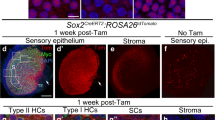Abstract
Loss of vestibular hair cells is a common cause of balance disorders. Current treatment options for bilateral vestibular dysfunction are limited. During development, atonal homolog 1 (Atoh1) is sufficient and necessary for the formation of hair cells and provides a promising gene target to induce hair cell generation in the mammals. In this study, we used a transgenic mouse line to test the age and cell type specificity of hair cell induction in the postnatal utricle in mice. We found that forced Atoh1 expression in vivo can induce hair cell formation in the utricle from postnatal days 1 to 21, while the efficacy of hair cell induction is progressively reduced as the animals become older. In the utricle, the induction of hair cells occurs both within the sensory region and in cells in the transitional epithelium next to the sensory region. Within the sensory epithelium, the central region, known as the striola, is most subjective to the induction of hair cell formation. Furthermore, forced Atoh1 expression can promote proliferation in an age-dependent manner that mirrors the progressively reduced efficacy of hair cell induction in the postnatal utricle. These results suggest that targeting both cell proliferation and Atoh1 in the utricle striolar region may be explored to induce hair cell regeneration in mammals. The study also demonstrates the usefulness of the animal model that provides an in vivo Atoh1 induction model for vestibular regeneration studies.






Similar content being viewed by others
References
Baker K, Brough DE, Staecker H (2009) Repair of the vestibular system via adenovector delivery of Atoh1: a potential treatment for balance disorders. Adv Otorhinolaryngol 66:52–63. doi:10.1159/000218207
Proctor L, Perlman H, Lindsay J, Matz G (1979) Acute vestibular paralysis in herpes zoster oticus. Ann Otol Rhinol Laryngol 88(3 Pt 1):303–310
Tsuji K, Velazquez-Villasenor L, Rauch SD, Glynn RJ, Wall C 3rd, Merchant SN (2000) Temporal bone studies of the human peripheral vestibular system. Aminoglycoside ototoxicity. Ann Otol Rhinol Laryngol Suppl 181:20–25
Tsuji K, Velazquez-Villasenor L, Rauch SD, Glynn RJ, Wall C 3rd, Merchant SN (2000) Temporal bone studies of the human peripheral vestibular system. Meniere's disease. Ann Otol Rhinol Laryngol Suppl 181:26–31
Barin K, Dodson EE (2011) Dizziness in the elderly. Otolaryngol Clin North Am 44(2):437–454. doi:10.1016/j.otc.2011.01.013, x
Vidal PP, de Waele C, Vibert N, Muhlethaler M (1998) Vestibular compensation revisited. Otolaryngol Head Neck Surg 119(1):34–42
Gillespie MB, Minor LB (1999) Prognosis in bilateral vestibular hypofunction. Laryngoscope 109(1):35–41
Albu S, Muresanu DF (2012) Vestibular regeneration–experimental models and clinical implications. J Cell Mol Med 16(9):1970–1977. doi:10.1111/j.1582-4934.2012.01540.x
Kawamoto K, Izumikawa M, Beyer LA, Atkin GM, Raphael Y (2009) Spontaneous hair cell regeneration in the mouse utricle following gentamicin ototoxicity. Hear Res 247(1):17–26. doi:10.1016/j.heares.2008.08.010
Forge A, Li L, Corwin JT, Nevill G (1993) Ultrastructural evidence for hair cell regeneration in the mammalian inner ear. Science 259(5101):1616–1619
Tanyeri H, Lopez I, Honrubia V (1995) Histological evidence for hair cell regeneration after ototoxic cell destruction with local application of gentamicin in the chinchilla crista ampullaris. Hear Res 89(1–2):194–202
Berggren D, Liu W, Frenz D, Van De Water T (2003) Spontaneous hair-cell renewal following gentamicin exposure in postnatal rat utricular explants. Hear Res 180(1-2):114–125
Bermingham NA, Hassan BA, Price SD, Vollrath MA, Ben-Arie N, Eatock RA, Bellen HJ, Lysakowski A, Zoghbi HY (1999) Math1: an essential gene for the generation of inner ear hair cells. Science 284(5421):1837–1841
Chen P, Johnson JE, Zoghbi HY, Segil N (2002) The role of Math1 in inner ear development: Uncoupling the establishment of the sensory primordium from hair cell fate determination. Development (Cambridge, England) 129(10):2495–2505
Gubbels SP, Woessner DW, Mitchell JC, Ricci AJ, Brigande JV (2008) Functional auditory hair cells produced in the mammalian cochlea by in utero gene transfer. Nature 455(7212):537–541. doi:10.1038/nature07265
Woods C, Montcouquiol M, Kelley MW (2004) Math1 regulates development of the sensory epithelium in the mammalian cochlea. Nat Neurosci 7(12):1310–1318. doi:10.1038/nn1349
Zheng JL, Gao WQ (2000) Overexpression of Math1 induces robust production of extra hair cells in postnatal rat inner ears. Nat Neurosci 3(6):580–586. doi:10.1038/75753
Izumikawa M, Minoda R, Kawamoto K, Abrashkin KA, Swiderski DL, Dolan DF, Brough DE, Raphael Y (2005) Auditory hair cell replacement and hearing improvement by Atoh1 gene therapy in deaf mammals. Nat Med 11(3):271–276. doi:10.1038/nm1193
Kawamoto K, Ishimoto S, Minoda R, Brough DE, Raphael Y (2003) Math1 gene transfer generates new cochlear hair cells in mature guinea pigs in vivo. J Neurosci 23(11):4395–4400
Schlecker C, Praetorius M, Brough DE, Presler RG Jr, Hsu C, Plinkert PK, Staecker H (2011) Selective atonal gene delivery improves balance function in a mouse model of vestibular disease. Gene Ther 18(9):884–890. doi:10.1038/gt.2011.33
Shou J, Zheng JL, Gao WQ (2003) Robust generation of new hair cells in the mature mammalian inner ear by adenoviral expression of Hath1. Mol Cell Neurosci 23(2):169–179
Staecker H, Praetorius M, Baker K, Brough DE (2007) Vestibular hair cell regeneration and restoration of balance function induced by math1 gene transfer. Otol Neurotol 28(2):223–231. doi:10.1097/MAO.0b013e31802b3225
Kelly MC, Chang Q, Pan A, Lin X, Chen P (2012) Atoh1 directs the formation of sensory mosaics and induces cell proliferation in the postnatal mammalian cochlea in vivo. J Neurosci 32(19):6699–6710. doi:10.1523/jneurosci. 5420-11.2012
Belteki G, Haigh J, Kabacs N, Haigh K, Sison K, Costantini F, Whitsett J, Quaggin SE, Nagy A (2005) Conditional and inducible transgene expression in mice through the combinatorial use of Cre-mediated recombination and tetracycline induction. Nucleic Acids Res 33(5):e51. doi:10.1093/nar/gni051
Hebert JM, McConnell SK (2000) Targeting of cre to the Foxg1 (BF-1) locus mediates loxP recombination in the telencephalon and other developing head structures. Dev Biol 222(2):296–306. doi:10.1006/dbio.2000.9732
Lumpkin EA, Collisson T, Parab P, Omer-Abdalla A, Haeberle H, Chen P, Doetzlhofer A, White P, Groves A, Segil N, Johnson JE (2003) Math1-driven GFP expression in the developing nervous system of transgenic mice. Gene Expr Patterns 3(4):389–395
Chen P, Segil N (1999) p27(Kip1) links cell proliferation to morphogenesis in the developing organ of Corti. Development (Cambridge, England) 126(8):1581–1590
Li S, Mark S, Radde-Gallwitz K, Schlisner R, Chin MT, Chen P (2008) Hey2 functions in parallel with Hes1 and Hes5 for mammalian auditory sensory organ development. BMC Dev Biol 8:20. doi:10.1186/1471-213x-8-20
Tang X, Falls DL, Li X, Lane T, Luskin MB (2007) Antigen-retrieval procedure for bromodeoxyuridine immunolabeling with concurrent labeling of nuclear DNA and antigens damaged by HCl pretreatment. J Neurosci 27(22):5837–5844. doi:10.1523/jneurosci. 5048-06.2007
Huang Y, Chi F, Han Z, Yang J, Gao W, Li Y (2009) New ectopic vestibular hair cell-like cells induced by Math1 gene transfer in postnatal rats. Brain Res 1276:31–38. doi:10.1016/j.brainres.2009.04.036
Lin V, Golub JS, Nguyen TB, Hume CR, Oesterle EC, Stone JS (2011) Inhibition of Notch activity promotes nonmitotic regeneration of hair cells in the adult mouse utricles. J Neurosci 31(43):15329–15339. doi:10.1523/jneurosci. 2057-11.2011
Staecker H, Schlecker C, Kraft S, Praetorius M, Hsu C, Brough DE (2014) Optimizing atoh1-induced vestibular hair cell regeneration. Laryngoscope 124(Suppl 5):S1–S12
Collado MS, Thiede BR, Baker W, Askew C, Igbani LM, Corwin JT (2011) The postnatal accumulation of junctional E-cadherin is inversely correlated with the capacity for supporting cells to convert directly into sensory hair cells in mammalian balance organs. J Neurosci 31(33):11855–11866. doi:10.1523/jneurosci. 2525-11.2011
Warchol ME, Lambert PR, Goldstein BJ, Forge A, Corwin JT (1993) Regenerative proliferation in inner ear sensory epithelia from adult guinea pigs and humans. Science 259(5101):1619–1622
Forge A, Li L, Nevill G (1998) Hair cell recovery in the vestibular sensory epithelia of mature guinea pigs. J Comp Neurol 397(1):69–88
Li L, Forge A (1997) Morphological evidence for supporting cell to hair cell conversion in the mammalian utricular macula. Int J Dev Neurosci 15(4–5):433–446
Li L, Nevill G, Forge A (1995) Two modes of hair cell loss from the vestibular sensory epithelia of the guinea pig inner ear. J Comp Neurol 355(3):405–417. doi:10.1002/cne.903550307
Werner M, Van De Water TR, Andersson T, Arnoldsson G, Berggren D (2012) Morphological and morphometric characteristics of vestibular hair cells and support cells in long term cultures of rat utricle explants. Hear Res 283(1-2):107–116. doi:10.1016/j.heares.2011.11.003
Zheng JL, Keller G, Gao WQ (1999) Immunocytochemical and morphological evidence for intracellular self-repair as an important contributor to mammalian hair cell recovery. J Neurosci 19(6):2161–2170
Ruben RJ (1967) Development of the inner ear of the mouse: a radioautographic study of terminal mitoses. Acta oto-laryngologica:Suppl 220:221–244
Wang J, Mark S, Zhang X, Qian D, Yoo SJ, Radde-Gallwitz K, Zhang Y, Lin X, Collazo A, Wynshaw-Boris A, Chen P (2005) Regulation of polarized extension and planar cell polarity in the cochlea by the vertebrate PCP pathway. Nat Genet 37(9):980–985
Suzuki M, Yamasoba T, Kaga K (1998) Development of the blood-labyrinth barrier in the rat. Hear Res 116(1–2):107–112
Cox BC, Dearman JA, Brancheck J, Zindy F, Roussel MF, Zuo J (2014) Generation of Atoh1-rtTA transgenic mice: a tool for inducible gene expression in hair cells of the inner ear. Scientific Reports 4:6885
Kopke RD, Jackson RL, Li G, Rasmussen MD, Hoffer ME, Frenz DA, Costello M, Schultheiss P, Van De Water TR (2001) Growth factor treatment enhances vestibular hair cell renewal and results in improved vestibular function. Proc Natl Acad Sci U S A 98(10):5886–5891. doi:10.1073/pnas.101120898
Acknowledgments
We thank laboratory members for helpful discussions. This work was supported by National Institutes of Health (NIH)–National Institute on Deafness and Other Communication Disorders Grant R01 DC05213 and in part by National Natural Science Foundation of China Grant 81271084, Natural Science Foundation of China Grant 81420108010 and Natural Science Foundation of China Grant 81400460.
Author information
Authors and Affiliations
Corresponding authors
Electronic supplementary material
Below is the link to the electronic supplementary material.

Fig. S1
Atoh1 induction is permanently poised in Foxg1-expressing cells. (A-B) GFP expression (A) under the expression cassette of rtTA-IRES-GFP is permanently activated in cells of the Foxg1-Cre lineage as diagramed in figure 1. At P21, Atoh1 expression reporter, Atoh1-nGFP, is expressed throughout the utricle epithelium including the sensory and transitional epithelia upon induction condition (Dox feeding) (B). Tri-allelic label indicates that the animals carry rtTA, Foxg1-Cre and TgAtoh1 alleles. Scale: 100 μm (A); 25 μm (B). (JPEG 3737 kb)
Rights and permissions
About this article
Cite this article
Gao, Z., Kelly, M.C., Yu, D. et al. Spatial and Age-Dependent Hair Cell Generation in the Postnatal Mammalian Utricle. Mol Neurobiol 53, 1601–1612 (2016). https://doi.org/10.1007/s12035-015-9119-0
Received:
Accepted:
Published:
Issue Date:
DOI: https://doi.org/10.1007/s12035-015-9119-0




